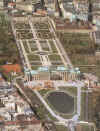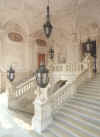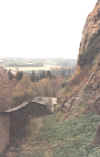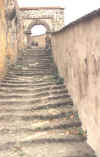![]()
Schloss Schoenbrunn, Vienna
![]()
Upper and Lower Belvedere, Vienna.
Upper Belvedere
Entrance Hall Upper Belvedere
Staircase, Upper Belvedere
Greater Marble Hall, Upper Belvedere
Lower Belvedere
![]()
![]()
Schloss Riegersburg, (1427) Baroque Castle, Hardegg, Lower Austria
![]()
Schloss Marschegg (1733), Lower Austria
![]()
Schloss Niederweiden. Lower Austria
![]()
Schloss Schlosshof, Lower Austria
![]()
Schloss Halbturn, (1711) Burgenland
![]()
Burg Schlaining (1271), Burgenland
![]()
Schloss Esterházy (1648), Eisenstadt, Burgenland
![]()
Schloss Riegersburg (1100 AD), Styria
An impressive landmark of Eastern Styria, this monumental fortress towers on to top of a volcanic rock. The oldest castle complex was built around 1100 A.D. The defense walls extend more than 3 kilometers. 11 bastions and 7 gate houses surround the 15 hectares on the large rocky plateau, rendering the citadel impregnable. It has been privately owned by the Liechtensteins since 1822. Today, 2 exhibitions are housed in 108 rooms of the fortress: The entire first floor, including the state rooms, are devoted to the 900 year old history of the princely Liechtenstein family.
Riegersburg from the front.
Riegersburg from the back. You can see the path going up the back in this picture too.
If you look closely at the left side of the picture, you can see the emergency exit snaking down the mountain at the back of the Riegersburg. It was quite a hike to get to the back entrance. It was commonly referred to as the "Mules Path" You can see why in the following pictures.
The mule path looking at it from the top down
The mules path looking at it from bottom up
![]()
Hochosterwitz, (1209) Carynthia
"Hochosterwitz was first mentioned in documents around 860. In
the year of 1209 the Spanheims  bestowed
upon the family of Osterwitz the hereditary office of the cup-bearer. The last
cup-bearer of Osterwitz was captured during a Turkish invasion and died in
prison, without leaving any descendants.
bestowed
upon the family of Osterwitz the hereditary office of the cup-bearer. The last
cup-bearer of Osterwitz was captured during a Turkish invasion and died in
prison, without leaving any descendants.
Schloss Hochosterwitz dates back to the sovereign, Emperor Frederic III. and King Ferdinand I. who pawned Osterwitz of to the governor Christof Khevenhüller. In 1570 Baron George Khevenhüller, acquired the citadel by purchase. In 1570-1586 he heavily fortifying the castle against the invading Turks, and provided it with an armory. He also had the 14 gates built to defend the access road. Such a fortress-road, secured on so many sites, cannot not only be counted among the greatest rarities, but it also represents a uniqueness in citadel- construction. According to a historical document, each gate has its own name.
Henceforth, no essential changes have taken place to the building. To the present day, the fortress has been continually owned by the Khevenhüller. A disposition left by the builder George Khevenhüller dating from the year 1576, which can be read on a marble slate in the yard, expresses the wish to keep the citadel in the possession of the descendants, and who should always care for it. This wish has always remained a holy legacy for the family Khevenhüller."
![]()
Please
send your suggestions and comments
to: steyrer@home.com![]()
![]()

















